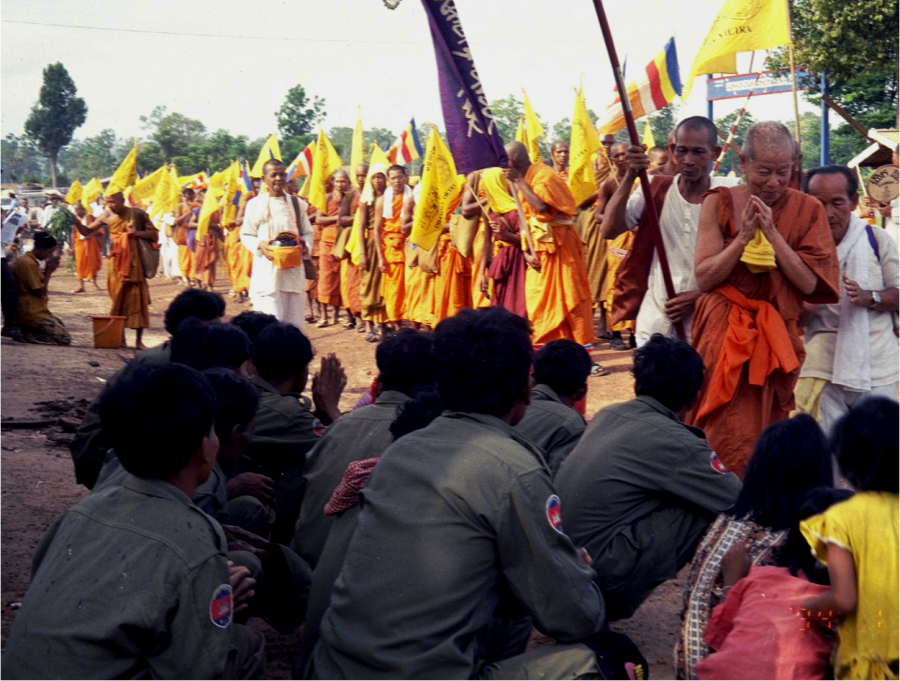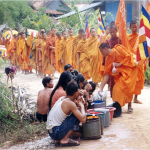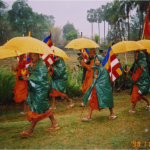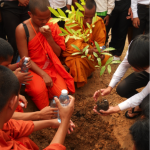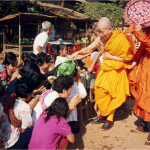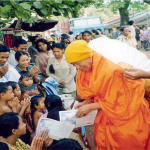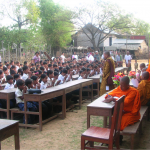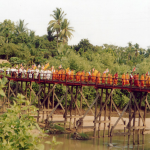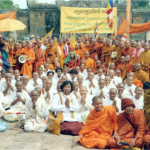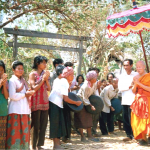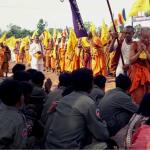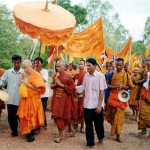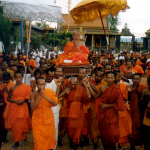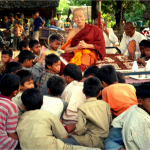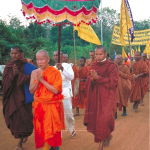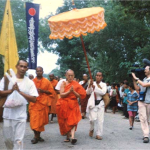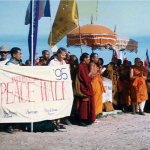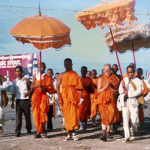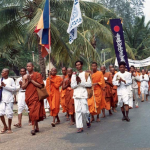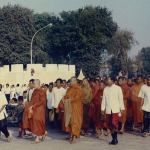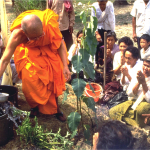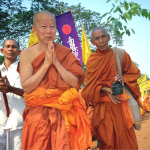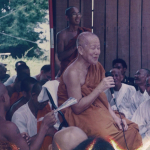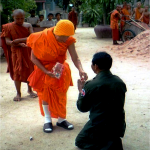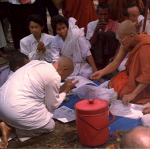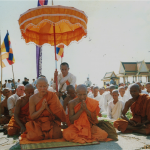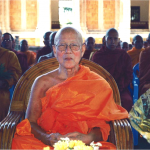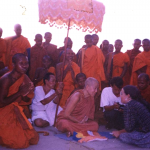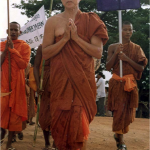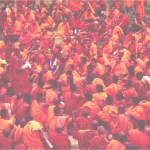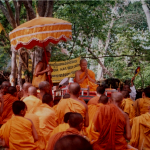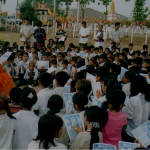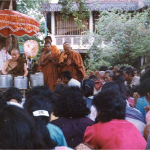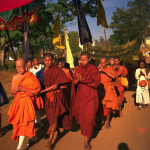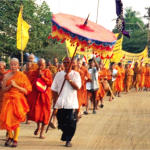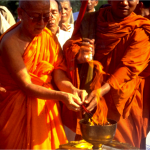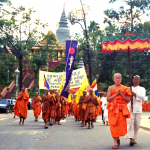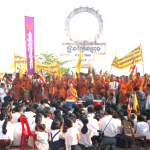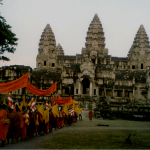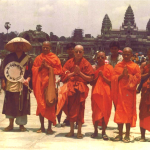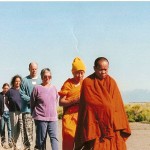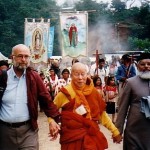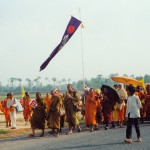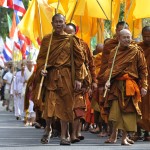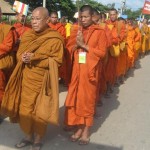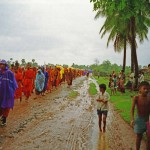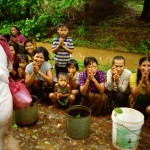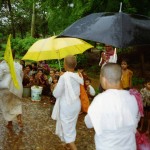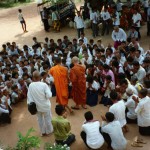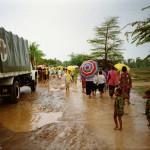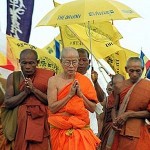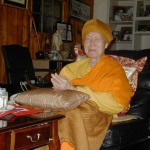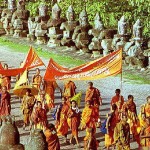CPCS receives first Peace Museum archives
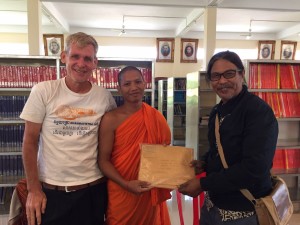
CPCS Co-founder and Peace Museum visionary Ngarm Soth Plai receives the archives from Venerable Tola and Bob Maat, who participated in the 1994 Dhammayietra.
On February 4, CPCS Co-founder and Peace Museum visionary Ngarm Soth Plai and CPCS Executive Director Emma Leslie accepted the first archives for the Cambodia Peace Museum from Venerable Tola and Bob Maat at Battambang Buddhist University.
The archives document the story of Venerable Samdech Preah Maha Ghosananda – a key figure in Cambodia’s post-Khmer Rouge and civil war period, who helped restore the nation state and initiated the famous Dhammayietra Peace Walks.
In addition to his tireless efforts to rebuild Cambodian Buddhism across the country following the devastation wrought by the Khmer Rouge on the religion, Maha Ghosananda represented the Cambodian Government-in-exile at the United Nations and launched numerous disarmament and de-mining activities in the post-conflict era.
In 1988, he led a contingent of monks to the UN-sponsored peace talks between the four warring Cambodian factions at the time. In recognition of a life of inspirational peacebuilding, Maha Ghosananda was nominated for the Nobel Peace Prize five times.
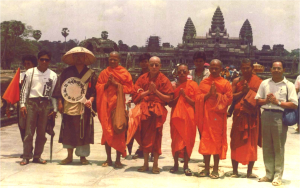
Dhammayietra walkers and Maha Ghosananda at Angkor Wat, Siem Reap 1992
Steps towards peace
Conceived in 1992 as a one-time event to help Cambodians move past fear and begin the reconciliation process after two decades of war, the Dhammayietra sought to teach peace by example, with its route passing through many of the country’s politically unstable, war-torn and landmine-ridden regions to promote peace.
The first walk took place in 1992 as the refugee camps on the Thai border were preparing to close with the planned repatriation of some 350,000 Cambodians.
Over 100 Cambodian refugees, joined by Maha Ghosananda and representatives from various international faith groups, monks, nuns and hundreds of local supporters, left the refugee camps on the Thai border to travel 450 kilometres through parts of Cambodia that continued to see outbreaks of conflict between guerrilla groups and government troops. By the time the walkers reached Phnom Penh, their number had swollen to more than 1,000.
Following Maha Ghosanda’s call that “We must walk where the troubles are”, each year the walkers carried messages of hope and peace through areas of the country that had known nothing but war.
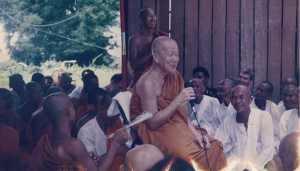
Maha Ghosananda addressing villages during the 1994 Dhammayietra
The second Dhammayietra in 1993 saw participants caught in a four-hour firefight between Khmer Rouge and government forces in Siem Reap before the walk had even begun. According to those that made the long journey to Phnom Penh, not a day went by without the sound of artillery, heavy weapons fire or landmines accompanying the sounds of their footsteps. That year, the Dhammayietra swelled to 3,000 walkers as it approached the capital city, where the atmosphere was extremely tense in the lead up to the elections.
The third Dhammayietra in 1994 passed through territory still littered with landmines and active soldiers from the Khmer Rouge and other factions. A monk and a nun were killed just five days after the walk commenced when the procession was caught in the crossfire between two groups in Bavel district in Battambang.
The Dhammayietra continued and 1,200 participants, including monks, nuns, lay people, local villagers and two foreigners concluded the walk at the Angkor Wat temples in Siem Reap on May 13, 1994.
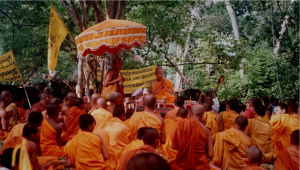
Dhammayietra 1997
The 1995 Dhammayietra took on extra international significance by joining with the Interfaith Pilgrimage for Peace and Life, which started in Auschwitz, Poland in December 1994 and made its way through 13 other countries to end in Hiroshima, Japan in August 1995 to mark 50 years since the end of World War II.
Thirty marchers from the global pilgrimage crossed the Thai border at Aranyprathet to join Maha Ghosananda and 400 monks and nuns as they walked together to the Vietnamese border calling for peace, reconciliation and an end to the suffering of the Cambodian people.
Again the Dhammayietra passed through active conflict areas, with the Khmer Rouge shelling Poipet in the days leading up to the walkers’ arrival, causing numerous deaths and injuries. The attacks paused as the walkers passed through the town, only to resume the next day.
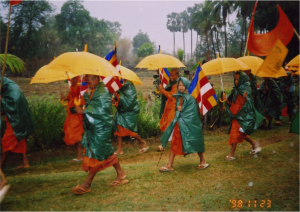
Walking in the rain, Dhammayietra in Kompong Thom province, 1998
Thousands lined the remote dusty roads as the walkers passed through heavily mined areas in temperatures up to 45 degrees and regular tropical monsoon downpours.
Villagers and soldiers alike joined the procession as it moved through various armed group territories, with monks provided education in non-violent approaches to resolving disputes and landmine awareness, as well as tree planting and water blessings as a means of reconnecting with the land and psychological purification.
On May 12, 1995, after 120 kilometres, the Dhammayietra was met by over 10,000 people in Battambang.
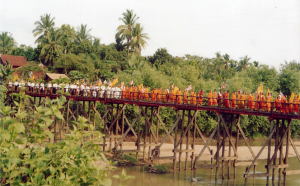
Dhammayietra passing through Pursat province, 2005
Towards social peace
Maha Ghosananda saw the walks as a space for both personal and societal transformation, without which social peace would never be attained.
“Peace will triumph over war when people can walk down the street with peace in their minds.” he said. “That’s the only step-by-step process that will bring an end to the great suffering of the Cambodian people.”
Maha Ghosananda message of reconciliation was all-inclusive, regardless of past transgressions, as he considered all Cambodians to be members of the same family.
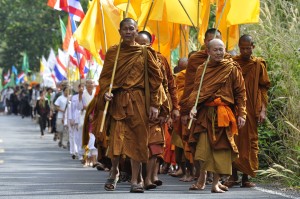 The journey continues
The journey continues
The Dhammayietra continued as an annual event which Maha Ghosananda led a number of times. During the following years, the walks faced many challenges traversing numerous simmering conflict zones in the country and accompanying streams of refugees seeking shelter from the violence or returning to their homes.
The Dhammayietra now takes place in May each year, attracting a large number of Buddhist monks and lay people who travel various routes in Cambodia.
In 2016, the 26th Dhammayietra will take place in Thma Puok district of Banteay Meanchey province between March 12-20. The walkers will be visiting remote villages in six communes in one district carrying messages focusing on promoting peace and decreasing violence from AIDS and other diseases, drug and alcohol abuse and destruction of the environment.
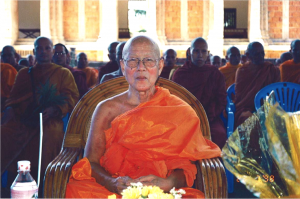 “CPCS is truly honoured to be given the opportunity to share Venerable Maha Ghosananda’s inspirational story and we would like to express our most sincere thanks and appreciation to the Battambang Buddhist University for their support of the Cambodia Peace Museum project,” said CPCS Executive Director Emma Leslie.
“CPCS is truly honoured to be given the opportunity to share Venerable Maha Ghosananda’s inspirational story and we would like to express our most sincere thanks and appreciation to the Battambang Buddhist University for their support of the Cambodia Peace Museum project,” said CPCS Executive Director Emma Leslie.
“We hope that by sharing Venerable Maha Ghosananda’s inspiring journey with a wider audience, people from Cambodia and the wider region can learn from the messages of hope, peace and reconcilitation that the Dhammayietra carries to this day.”
For more information about participating in the 2016 Dhammayietra or to find out how you can support the Peace Walk, please contact [email protected], [email protected] or [email protected].
Gallery
Click on any photo below to open the photo browser.

